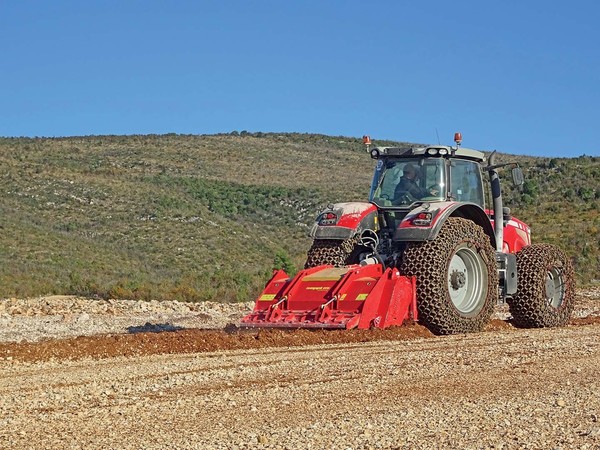
Combined stone crushers and cutters for excellent results in forestry
Designed explicitly for ordinary and extraordinary maintenance in woodland and forestry environments, stone crushers and combined forestry cutters not only finely chop the soil but also crush stones and shred branches, stumps, and roots
For optimal maintenance of woodlands and forests, it is essential to have machinery that shreds branches, stumps, and roots but can also crush stones and pebbles simultaneously. This is particularly useful where it is necessary to adequately prepare the ground for the subsequent planting of new trees.
The association of the two functions (shredding and crushing) is also beneficial in urban contexts, such as in parks or for the care of public green areas. Both operations can, in fact, be carried out in a single pass, thus optimizing working time and costs.
Because of the challenging operating conditions, stone crushers and combined cutters are designed to perform both functions to the best of their ability and are therefore made of highly durable materials. The crushing devices work on stones and rocks with typical sizes (ideally, the diameter of a sphere) from 10-15 up to 50 cm depending on the models, just like branches, roots, and twigs, which can be crushed up to 50 cm in diameter.
These machines have various drive options for particularly heavy-duty work, such as selecting the input speed from the tractor's PTO, i.e., 540 rpm for crushing stones and rocks and for deep soil working, or 1000 rpm for chopping woody material and surface milling.
The stone crushers are equipped with internal counter-blades, adjustable in their position to allow to select the desired size of the output material. Also, the crankcases are adjustable (using hydraulic cylinders) as far as their inclination is concerned in order to manage the level of final refinement and set the direction of exit of the resulting materials. For self-evident safety reasons, the crankcases and the structure of the entire machine are made of high-strength steel to ensure adequate strength against shocks and stresses in general.
The working parts are made up of a sturdy shaft on which massive crushing hammers are inserted (in variable numbers depending on the working width) made of high-resistance steel, extremely resistant to both impacts and wear, thanks to specific tungsten carbide inserts. The hammers are rectangular with rounded corners and may be hinged to the rotor or fixed if flanged and welded to the rotor.
Due to the particularly high power demand (from 70 to 450 HP approx.), typical working widths are somewhat limited, also because of the operational difficulties, with work often taking place in narrow spaces and/or on uneven surfaces. Maneuverability is, therefore, an essential prerequisite. Indeed, the majority of models have working widths between 1.75 and 2.5 m, although they can also reach 3.5 m. For these reasons, forward speeds are rather limited, with the maximum usually not exceeding 2 km/h. Therefore, in order to ensure proper operation, coupling with tractors equipped with the super-reducer or continuously variable transmission is required. When the amount of stones and rocks is not predominant, speed can increase up to 5 km/h, again combining surface tillage with stone crushing and/or shredding of woody material.
These machines can be used for a wide range of purposes, even in non-agricultural contexts. They range from the creation of firebreaks (especially in forestry) to the use in orchards to reduce the size of the skeleton or to promote crops in virgin soils rich in skeleton and woody residues. It is even possible to build from scratch or carry out extraordinary maintenance of dirt roads and forestry roads and treat rubble on construction sites.
Market offers
One of the various manufacturers on the market is the Italian company Seppi, which offers various solutions according to the purpose of use. On request, for stone crushers combined with forestry cutters, ADAM offers an original solution for fastening the machine to the corners of the tractor's tow bar structure, creating an articulated quadrilateral, so that the machine can work with different inclinations on the ground while maintaining equal and competing joint angles of the two joints of the Cardan shaft connecting the grooved tongue of the tractor with the implement's power take-off, thus making it constantly work in the best-operating conditions.
The transmission of motion from the tractor's PTO to the rotor is carried out with wide-toothed belts made of "Carbonchain" rubber and with a highly resistant, stable, and flexible section due to the high power involved.
Among the several available options, it is worth mentioning a two-speed transmission, the Cardan shaft implemented with the torque limiter, and the hydraulically regulated compactor roller to define the depth of work. Finally, if the tractor is equipped with ISOBUS, some models can operate in compliance with the ISOBUS protocol to optimize the equipment functions.
The FAE Group also offers a wide range of stone crushers and forestry shredders, including some hydraulically-operated combined models, which are therefore also suitable for coupling to other drive units other than agricultural tractors. SFM/PM and SFH/PM have working widths of up to about 2.5 m and a capacity for shredding tree stumps up to a diameter of 55 cm, making them stand out for their high performance. Nonetheless, they require hydraulic pressures of up to 415 bar and flow rates of 530 l/min, performance levels not (yet) available on agricultural tractors.








